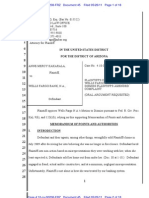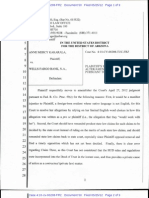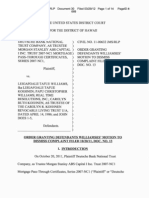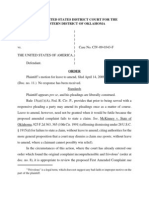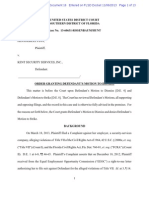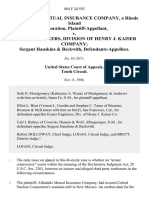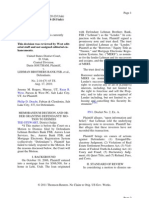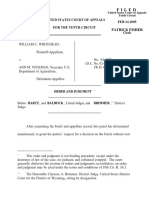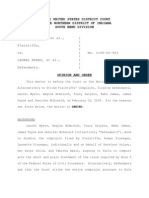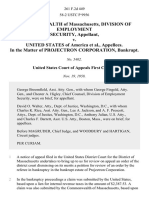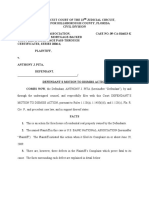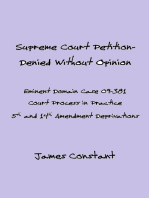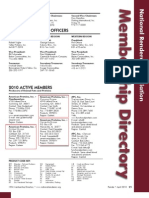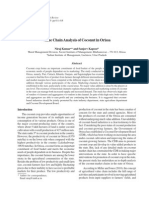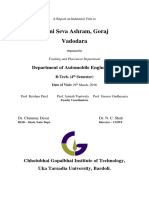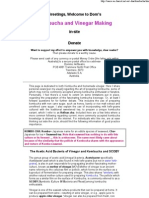Order Regarding Motion To Dismiss Consolidated Amended Complaint
Order Regarding Motion To Dismiss Consolidated Amended Complaint
Uploaded by
amannix3112Copyright:
Available Formats
Order Regarding Motion To Dismiss Consolidated Amended Complaint
Order Regarding Motion To Dismiss Consolidated Amended Complaint
Uploaded by
amannix3112Original Title
Copyright
Available Formats
Share this document
Did you find this document useful?
Is this content inappropriate?
Copyright:
Available Formats
Order Regarding Motion To Dismiss Consolidated Amended Complaint
Order Regarding Motion To Dismiss Consolidated Amended Complaint
Uploaded by
amannix3112Copyright:
Available Formats
Case3:11-cv-04766-JSW Document123 Filed10/30/12 Page1 of 11
1 2 3 4 5 6 7 FOR THE NORTHERN DISTRICT OF CALIFORNIA 8 9 10 MATTHEW EDWARDS, et al., Plaintiffs, v. NATIONAL MILK PRODUCERS FEDERATION, aka COOPERATIVES WORKING TOGETHER, et al., Defendants. / 15 16 17 18 19 20 21 22 23 24 25 26 27 28 Now before the Court is the motion to dismiss filed by Defendants. The Court finds that this matter is appropriate for disposition without oral argument and is deemed submitted. See N.D. Cal. Civ. L.R. 7-1(b). Accordingly, the hearing set for November 2, 2012 is hereby VACATED. Having carefully reviewed the parties papers, considered their arguments and the relevant legal authority, the Court hereby denies Defendants motion to dismiss.1 BACKGROUND Defendants are moving to dismiss Plaintiffs complaint on the grounds that this Court lacks jurisdiction to adjudicate this matter. Defendants are also moving to dismiss Plaintiffs claims on the grounds that they fail to state a claim. The Court will address additional facts as necessary in the remainder of this Order. /// /// ///
1
IN THE UNITED STATES DISTRICT COURT
No. C 11-04766 JSW
United States District Court
11
For the Northern District of California
12 13 14
ORDER REGARDING MOTION TO DISMISS CONSOLIDATED AMENDED COMPLAINT
The Court GRANTS Defendants request for judicial notice. See Fed. R. Evid. 201.
Case3:11-cv-04766-JSW Document123 Filed10/30/12 Page2 of 11
1 2 3 4 5 6 7 8 9 10 A. Applicable Legal Standards.
ANALYSIS
Respondents move to dismiss pursuant to Federal Rule of Civil Procedure 12(b)(1), for lack of subject matter jurisdiction, and Rule 12(b)(6), for failure to state a claim. When a defendant moves to dismiss a complaint or claim for lack of subject matter jurisdiction the plaintiff bears the burden of proving that the court has jurisdiction to decide the claim. Thornhill Publn Co. v. Gen. Tel. & Elecs. Corp., 594 F.2d 730, 733 (9th Cir. 1979). A motion to dismiss for lack of subject matter jurisdiction under Rule 12(b)(1) may be facial or factual. Safe Air for Everyone v. Meyer, 373 F.3d 1035, 1039 (9th Cir. 2004). A facial attack on the jurisdiction occurs when factual allegations of the complaint are taken as true. Fedn of African Am. Contractors v. City of Oakland, 96 F.3d 1204, 1207 (9th Cir. 1996). The plaintiff is then entitled to have those facts construed in the light most favorable to him or her. Id. A factual attack on subject matter jurisdiction occurs when defendants challenge the actual lack of jurisdiction with affidavits or other evidence. Thornhill, 594 F.2d at 733. In a factual attack, plaintiff is not entitled to any presumptions or truthfulness with respect to the allegations in the complaint, and instead must present evidence to establish subject matter jurisdiction. Id. A motion to dismiss is proper under Rule 12(b)(6) where the pleadings fail to state a claim upon which relief can be granted. The Court construes the allegations in the complaint in the light most favorable to the non-moving party and all material allegations in the complaint are taken to be true. Sanders v. Kennedy, 794 F.2d 478, 481 (9th Cir. 1986). However, even under the liberal pleading standard of Rule 8(a)(2), a plaintiffs obligation to provide the grounds of his entitle[ment] to relief requires more than labels and conclusions, and a formulaic recitation of the elements of a cause of action will not do. Bell Atlantic Corp. v. Twombly, 550 U.S. 544, 555 (2007) (citing Papasan v. Allain, 478 U.S. 265, 286 (1986)). Pursuant to Twombly, a plaintiff must not merely allege conduct that is conceivable but must instead allege enough facts to state a claim to relief that is plausible on its face. Id. at 570. A claim has facial plausibility when the plaintiff pleads factual content that allows the 2
United States District Court
11
For the Northern District of California
12 13 14 15 16 17 18 19 20 21 22 23 24 25 26 27 28
Case3:11-cv-04766-JSW Document123 Filed10/30/12 Page3 of 11
1 2 3 4 5 6 7 8 9 10
court to draw the reasonable inference that the defendant is liable for the misconduct alleged. Ashcroft v. Iqbal, 556 U.S.662, 678 (2009) (citing Twombly, 550 U.S. at 556). The plausibility standard is not akin to a probability requirement, but it asks for more than a sheer possibility that a defendant has acted unlawfully.... When a complaint pleads facts that are merely consistent with a defendants liability, it stops short of the line between possibility and plausibility of entitlement to relief. Id. (quoting Twombly, 550 U.S. at 557) (internal quotation marks omitted). If the allegations are insufficient to state a claim, a court should grant leave to amend, unless amendment would be futile. See, e.g., Reddy v. Litton Indus., Inc., 912 F.2d 291, 296 (9th Cir. 1990); Cook, Perkiss & Liehe, Inc. v. N. Cal. Collection Serv., Inc., 911 F.2d 242, 246-47 (9th Cir. 1990). B. Defendants Motion. 1. Whether the Secretary of Agriculture has Exclusive or Primary Jurisdiction.
United States District Court
11
For the Northern District of California
12 13 14 15 16 17 18 19 20 21 22 23 24 25 26 27 28 Section 1 provides: Persons engaged in the production of agricultural products as farmers, planters, ranchmen, dairymen, nut or fruit growers may act together in associations, corporate or otherwise, with or without capital stock, in collectively processing, preparing for market, handling, and marketing in interstate and foreign commerce, such products of persons so engaged. Such associations may have marketing agencies in common; and such associations and their members may make the necessary contracts and agreements to effect such purposes: Provided, however, That such associations are operated for the mutual benefit of the members thereof, as such producers, and conform to one or both of the following requirements: First. That no member of the association is allowed more than one vote because of the amount of stock or membership capital he may own therein, or, Second. That the association does not pay dividends on stock or membership capital in excess of 8 per centum per annum. And in any case to the following: Third. That the association shall not deal in the products of nonmembers to an amount greater in value than such as are handled by it for members. 7 U.S.C. 291 (emphasis in original).
2
Section 1 of the Capper-Volstead Act provides agricultural cooperatives with a limited exception to liability for antitrust violations under the Sherman Act.2 Section 2 provides for procedures by which the Secretary of the United States Department of Agriculture (Secretary) may act if he or she has reason to believe that any such association described in Section 1
Case3:11-cv-04766-JSW Document123 Filed10/30/12 Page4 of 11
1 2 3 4 5 6 7 8 9 10
monopolizes or restrains trade to such an extent that the price of any agricultural product is unduly enhanced. See 7 U.S.C. 292. Defendants argue that Section 2 of this statute vests exclusive jurisdiction to the Secretary to determine whether the conduct by those engaged in milk production or marketing is covered by the exemption from antitrust liability provided by Section 1. In support of this argument, Defendants rely upon the language of the Capper-Volstead Act and the fact that the price of raw milk is subject to comprehensive regulation and controls administered by the Secretary pursuant to the Agricultural Marketing Agreement Act of 1937 (AMAA), 7 U.S.C. 601, et seq., and the Agricultural Marketing Act of 1929, 12 U.S.C. 1141, et seq. However, the Supreme Court has expressly considered and rejected this argument. See United States v. Borden, 308 U.S. 188, 204-206 (1939). In Borden, the lower court: deduced from the Capper-Volstead Act that the [Secretary] has exclusive jurisdiction to determine and order, in the first instance, whether or not farmer cooperatives, in their operation, monopolize and restrain interstate trade and commerce to such an extent that the price of any agricultural product is unduly enhanced. Until the [Secretary] acts, the judicial power cannot be invoked. Id. at 203-204. Supreme Court conclusively rejected this proposition. Id. at 204 (We are unable to accept this view.). The Court explained that it found no ground for saying that the limited procedure set forth in Section 2 of the Capper-Volstead Act was a substitute for the provisions of the Sherman Act, or has the result of permitting the sort of combinations and conspiracies here charged unless the [Secretary] takes action. ... Section two of the CapperVolstead Act contains no provision giving immunity from the Sherman Act in the absence of a proceeding by the Secretary. Id at 206. The Court further explained that the procedure under Section two of the Capper-Volstead Act is auxiliary... . Id. Section two is not to be deemed to be designed to take the place of, or to postpone or prevent, prosecution under Section one of the Sherman Act... . Id. More than twenty years later, the Supreme Court again considered and soundly rejected the argument that the procedure under Section 2 of the Capper-Volstead Act provides the Secretary with exclusive or primary jurisdiction over any prosecutions under the Sherman Act. See Maryland & Virginia Milk Producers Assn v. United States, 362 U.S. 458, 462-63 (1960). 4
United States District Court
11
For the Northern District of California
12 13 14 15 16 17 18 19 20 21 22 23 24 25 26 27 28
Case3:11-cv-04766-JSW Document123 Filed10/30/12 Page5 of 11
1 2 3 4 5 6 7 8 9 10
In Maryland & Virginia, the defendant argued that Section 2 was intended to give the Secretary primary jurisdiction, and thereby exclude any prosecutions under the Sherman Act. . Id. at 462-63. The Court stated that it had unequivocally rejected the same contention in [Borden] ... and that it again adhered to the reasoning and holding of Borden on this point. Id. at 463; see also Dairymen, Inc. v. Federal Trade Commn., 684 F.2d 376, 379 (6th Cir. 1982) (It is clear ... that the Secretarys jurisdiction is not exclusive.) (citing Borden, 308 U.S. at 205-206 and Maryland & Virginia, 362 U.S. at 462-63). Notably, the Court did not use any limiting language, indicating that the rejection of primary or exclusive jurisdiction was limited to the factual circumstances presented in Borden or in Maryland & Virginia. Id. at 463. The Courts rejection of Defendants proposition was clear and unequivocal. Id. Therefore, there are no grounds upon which this Court may limit the Supreme Courts holdings in Borden and Maryland & Virginia.3 Accordingly, the Court finds that it has jurisdiction to consider Plaintiffs antitrust claim. 2. Whether Referal to the Secretary Under the Primary Jurisdiction Doctrine is Appropriate.
United States District Court
11
For the Northern District of California
12 13 14 15 16 17 18 19 20 21 22 23 24 25 26 27 28
Defendants also move, in the alternative, to have this Court refer this matter to the Secretary pursuant to the primary jurisdiction doctrine. Under this doctrine, courts may exercise discretion to stay an action pending referral of the issues to an administrative body. Chabner v. United Omaha Life Ins. Co., 225 F.3d 1042, 1051 (9th Cir. 2000). Although courts use the word referral to explain the primary jurisdiction doctrine, this word is perhaps not the most accurate term to describe this process, as most statutes do not authorize courts to require an agency to issue a ruling. ... Rather, the court merely stays or dismisses proceedings
Because the Court finds that the Supreme Courts rejection of the proposition that the Secretary has exclusive or primary jurisdiction is not limited to the factual circumstances raised in Borden and in Maryland & Virginia, the Court need not evaluate at this time whether Plaintiffs have sufficiently alleged predatory conduct, whether the cooperatives were operated for the mutual benefit of its members, or whether supply restraints are included in the exemption provided by Section 1 of the Capper-Volstead Act. As Defendants clarify in their reply, they are not seeking a ruling from this Court regarding whether their alleged conduct is immune from antitrust liability pursuant to Section 1 of the Capper-Volstead Act. (Reply at 1.)
3
Case3:11-cv-04766-JSW Document123 Filed10/30/12 Page6 of 11
1 2 3 4 5 6 7 8 9 10
to allow the plaintiff to pursue administrative remedies. Clark v. Time Warner Cable, 523 F.3d 1110, 1115 n. 9 (9th Cir. 2008) (internal citation omitted) (emphasis in original). This doctrine is applicable when a claim is originally cognizable in the courts, but is also subject to a regulatory scheme that is enforced by an administrative body of special competence. Chabner, 225 F.3d at 1051. [N]o rigid formula exists for applying the primary jurisdiction doctrine. Id. A court may consider: 1) whether application will enhance court decision-making and efficiency by allowing the court to take advantage of administrative expertise; and 2) whether application will help assure uniform application of regulatory laws. Id. However, as noted above, most statutes do not authorize a court to require an agency to issue a ruling. Defendants do not point to any statute or regulation that provides for such authority here. Moreover, Defendants have not shown that there is a provision whereby Plaintiffs could request action by the Secretary. Accordingly, if the Court stayed or dismissed these proceedings to allow Plaintiffs to pursue administrative remedies, it is not clear that there is any avenue to ensure that the Secretary would actually address the jurisdictional issue. Even more importantly, Borden and Maryland & Virginia preclude this Court from referring this matter to the Secretary. The Supreme Court has already determined that the Secretary does not have primary or exclusive jurisdiction. See Borden, 308 U.S. at 204-206; Maryland & Virginia, 362 U.S. at 462-63. In light of the Supreme Courts holdings in Borden and Maryland & Virginia, there is no basis for this Court to defer jurisdiction to the Secretary over Plaintiffs claims.4 The Court thus denies Defendants motion on this ground.
United States District Court
11
For the Northern District of California
12 13 14 15 16 17 18 19 20 21 22 23 24 25 26 27 28
In a footnote, Defendants argue that the Supreme Courts holdings in Credit Suisse Securities (USA) LLC v. Billing, 551 U.S. 264 (2007) and Verizon Communications, Inc. v. Law Offices of Curtis V. Trinko, LLP, 540 U.S. 398 (2004) underscore the point that the Court should refer this matter to the Secretary to make an initial jurisdictional determination. However, Credit Suisse and Verizon are inapplicable and do not support a finding that the Court should defer ruling pursuant to the primary jurisdiction doctrine. In Credit Suisse, the question before the Supreme Court was whether there was a plain repugnancy between the plaintiffs antitrust claims and the federal securities law. Id., 551 U.S. at 267. The Court explained that an implied repeal of the antitrust laws could be found where there is a plain repugnancy between the antitrust law and regulatory provisions. Id. at 271 (citing Gordon v. New York Stock Exchange, Inc., 422 U.S. 659, 682 (1975). In determining whether there is a clear repugnancy between the securities law and the antitrust complaint, the Supreme
4
Case3:11-cv-04766-JSW Document123 Filed10/30/12 Page7 of 11
1 2 3 4 5 6 7 8 9 10
3.
Whether the Filed-Rate Doctrine Applies.
Defendants contend that Plaintiffs claims are barred by the filed-rate doctrine. The [filed-rate] doctrine is a judicial creation that arises from decisions interpreting federal statutes that give federal agencies exclusive jurisdiction to set rates for specified utilities, originally through rate-setting procedures involving the filing of rates with the agencies. E. & J. Gallo Winery v. Encana Corp., 503 F.3d 1027, 1033 (9th Cir. 2007). At its most basic, the filed rate doctrine provides that state law, and some federal law (e.g. antitrust law), may not be used to invalidate a filed rate nor to assume a rate would be charged other than the rate adopted by the federal agency in question. Wah Chang v. Duke Energy Trading & Mktg., LLC, 507 F.3d 1222, 1225 (9th Cir. 2007) (quoting Transmission Agency v. Sierra Pac. Power Co., 295 F.3d 918, 929-30 (9th Cir. 2002)); see also Wegoland Ltd. v. NYNEX Corp., 27 F.3d 17, 18 (2d Cir. 1994) (Stated simply, [the filed rate] doctrine holds that any filed rate that is, one approved by the governing regulatory agency is per se reasonable and unassailable in judicial proceedings brought by ratepayers.). The Ninth Circuit recently held that the filed rate doctrine applies to, and thus bars, Farm Milk Marketing Orders (FMMO) price-related claims. See Carlin v. DairyAmerica, Inc., 688 F.3d 1117, 1140 (9th Cir. 2012). Pursuant to the AMAA, the United States Department of Agriculture (USDA) issues FMMOs which set the minimum price which may be charged for raw milk. Id. at 1120. The Ninth Circuit reasoned that the filed rate doctrine should apply because milk pricing is the subject of extensive federal statutory and regulatory control[,] the USDA sets minimum prices for raw milk from which there can be no downward Court has treated the following factors as critical: (1) the existence of regulatory authority under the securities law to supervise the activities in question; (2) evidence that the responsible regulatory entities exercise that authority; and (3) a resulting risk that the securities and antitrust laws, if both applicable, would produce conflicting guidance, requirements, duties, privileges, or standards of conduct. Id. at 275-76. The Court further noted that it also considers whether the possible conflict affected practices that lie squarely within an area of financial market activity that the securities law seeks to regulate. Id. at 276; see also id. at 285. Defendants have not demonstrated, and do not even argue, that there is a clear or plain repugnancy between any law and Plaintiffs antitrust claims based upon these factors. In Verizon, the Supreme Court determined that an alleged breach by an incumbent telephone company under the Telecommunications Act of 1996 of its duty to share its network with its competitors did not state a monopoly or attempted monopoly claim under Section 2 of the Sherman Act. Id., 540 U.S. at 401, 410-415. Verizon is inapposite. 7
United States District Court
11
For the Northern District of California
12 13 14 15 16 17 18 19 20 21 22 23 24 25 26 27 28
Case3:11-cv-04766-JSW Document123 Filed10/30/12 Page8 of 11
1 2 3 4 5 6 7 8 9 10
departure from the rate, and the underlying justifications for the filed rate doctrine apply to FMMO prices set under the AMAA. Id. at 1131. In sum, the USDA did possess the authority and did exercise it to address problems as to the agency-set minimum prices for raw milk under the FMMOs, such that the filed rate doctrine is applicable in the present AMAA situation. Id. at 1134. Nevertheless, the Ninth Circuit noted that, in contrast to the typical filed rate scenario, the rates set by FMMOs consist of only minimum prices from which the prices charged may be increased. Id. at 1130 (emphasis in original). The AMAA does not mandate a maximum price. Parties can and do, negotiate premiums, known as over-order prices, for the sale of milk. Id. at 1120 (quoting Farmers Union Milk Mktg Coop. v. Yeutter, 930 F.2d 466, 468-69 (6th Cir. 1991)). Here, Plaintiffs allege that by manipulating the supply of raw milk through herd retirement, Defendants have suppressed price competition and thereby artificially raised prices. (CAC, 15.) As a result, indirect purchasers of milk and fresh milk products have paid supracompetitive prices. (Id. at 124.) Plaintiffs further plead that the over-order price of milk is unregulated and determined solely by market forces; the allegedly inflated over-order prices charged by Defendants were never approved by the USDA. (Id. at 128.) Plaintiffs claims are premised on the over-order prices of raw milk which resulted in higher wholesale and retail prices of milk and fresh milk products. They do not challenge the minimum prices set by the FMMOs. (Id. at 129, 130.) Other courts who have examined whether the filed-rate doctrine bars claims related to over-order prices, as opposed to the regulated minium prices, have found that it does not. See Ice Cream Liquidation, Inc. v. Land OLakes, Inc., 253 F. Supp. 2d 262, 275-76 (D.Conn. 2003); In re Southeastern Milk Antitrust Litig., 2008 WL 2368212, *7-8 (E.D. Tenn. June 6, 2008). In Ice Cream Liquidation, the court found that the plaintiff was not challenging the minimum milk rates set by the USDA through the FMMOs. Id., 253 F. Supp. 2d at 275. Instead, the plaintiff challenged the defendants inflated whole-sale milk prices in excess of the minimum milk prices, which ... were never approved by the USDA. Id. at 276. The court 8
United States District Court
11
For the Northern District of California
12 13 14 15 16 17 18 19 20 21 22 23 24 25 26 27 28
Case3:11-cv-04766-JSW Document123 Filed10/30/12 Page9 of 11
1 2 3 4 5 6 7 8 9 10
reasoned that because the prices challenged by the plaintiff were never regulated or approved by the USDA, the filed rate doctrine was inapplicable. Id. Similarly, in Southeastern Milk, the plaintiffs challenged the elimination of competition and the fixing of over-order premiums[,] not the minimum raw milk prices established by the USDA. Id., 2008 WL 2368212 at *7. The prices challenged were not regulated by the USDA. Id. As the court noted, [a]lthough the AMAA has reduced competition in the milk industry significantly, market forces still play a substantial role in the prices actually paid to dairy farmers and cooperatives for the milk they produce. While Congress did authorize the [Secretary] to set certain minimum prices, Congress specifically left the determination of milk prices above this floor to market forces. Id. The plaintiffs alleged that the defendants stifled competition and fixed prices to the extent they are determined by market forces. Id. Their claims centered around prices that are neither regulated nor approved by the [USDA]. Id. Therefore, the court found that the plaintiffs complaint did not require the court to engage in judicial rate making and to substitute its judgment for that of the [USDA][,] and thus determined that the filed rate doctrine was not implicated. Id., 2008 WL 2368212 at *8. The Court finds the reasoning of Ice Cream Liquidation and Southeastern Milk persuasive. As discussed above, Plaintiffs are not challenging the minimum milk prices for raw milk set by the USDA. Instead, they contend that Defendants practices limited competition and artificially inflated over-order prices. These over-order prices are not regulated or approved by the USDA. Defendants argue that the over-order prices are regulated by the USDA because the USDA publishes a report on the over-order prices. The Court is not convinced. Defendants have not demonstrated that merely reporting what prices are constitutes sufficient regulation to qualify for the filed rate doctrine.5 Significantly, the USDA does not approve or
United States District Court
11
For the Northern District of California
12 13 14 15 16 17 18 19 20 21 22 23 24 25 26 27 28
Defendants also point to the fact that the Secretary is authorized, pursuant to Section 2 of the Capper-Volstead Act, to bring an action if he or she believes that agricultural prices have been unduly enhanced. See 7 U.S.C. 292. However, ability of the Secretary in certain circumstances to bring an action does not mean that the Secretary has actually set and approved of the over-order prices. If that were the case, the filed-rate doctrine would apply in every instance in which an agency has the ability to bring an action regarding prices charged. Defendants have not shown that the Secretary has exercised this procedure under the Capper-Volstead Act to effectively regulate and control the over-order prices to the
5
Case3:11-cv-04766-JSW Document123 Filed10/30/12 Page10 of 11
1 2 3 4 5 6 7 8 9 10
authorize over-order prices. The FMMOs merely set the minimum raw milk prices. Accordingly, Defendants have not shown that Plaintiffs complaint would require the court to engage in judicial rate making and to substitute its judgment for that of the [USDA]. Southeastern Milk, 2008 WL 2368212 at *8. Therefore, the Court denies Defendants motion to dismiss based on the filed-rate doctrine. 4. Whether the Statutes of Limitations Bars Plaintiffs Claims.
Defendants argue that Plaintiffs claims seek damages outside of the statute of limitations period and that tolling does not apply. According to Defendants, in light of the public announcements regarding the herd retirement program, a reasonably prudent person would have been on notice of a potentially actionable injury when the program was first implemented in 2003. (Mot. at 19.) Plaintiffs allege that they were not aware of Defendants anticompetitive conduct until shortly before September 2011. (CAC, 146.) In response to Defendants motion, Plaintiffs argue that they should not have been expected to discover Defendants conduct sooner. Defendants communicated with their own members. Consumers purchasing milk at their local supermarket would have no reason to review Cooperatives Working Togethers website or read industry newsletters. (Opp. at 19.) The Court finds that the timing of when a reasonable plaintiff would have discovered Defendants conduct is a factual question which may not be resolved on a motion to dismiss. Accordingly, the Court denies Defendants motion to dismiss based on statute of limitations grounds.6 CONCLUSION For the foregoing reasons, the Court DENIES Defendants motion to dismiss. However, as the Court noted, to the extent Plaintiffs intend to rely on a theory of fraudulent concealment,
United States District Court
11
For the Northern District of California
12 13 14 15 16 17 18 19 20 21 22 23 24 25 26 27 28
extent necessary to implicate the filed-rate doctrine.
6 However, the Court does note that, to the extent Plaintiffs intend to rely on a theory of fraudulent concealment, Plaintiffs have not plead facts in support of such a theory with sufficient particularity. If Plaintiffs seek to pursue this legal theory, they should file an amended complaint by no later than November 15, 2012.
10
Case3:11-cv-04766-JSW Document123 Filed10/30/12 Page11 of 11
1 2 3 4 5 6 7 8 9 10
they have not pled sufficient supporting allegations. If Plaintiffs seek to pursue this legal theory, they should file an amended complaint by no later than November 15, 2012. IT IS SO ORDERED.
Dated: October 30, 2012 JEFFREY S. WHITE UNITED STATES DISTRICT JUDGE
United States District Court
11
For the Northern District of California
12 13 14 15 16 17 18 19 20 21 22 23 24 25 26 27 28 11
You might also like
- Laurelwood FileDocument19 pagesLaurelwood Filethe kingfishNo ratings yet
- Affirmation in Opposition To Motion To Dismiss 5.17.2022Document9 pagesAffirmation in Opposition To Motion To Dismiss 5.17.2022Manasi HansaNo ratings yet
- Opposition To Motion To Dismiss - FILEDDocument18 pagesOpposition To Motion To Dismiss - FILEDVince4azNo ratings yet
- Homeowner Victory in Ca VS ChaseDocument23 pagesHomeowner Victory in Ca VS ChaseMortgage Compliance Investigators100% (2)
- Dobyns RulingDocument7 pagesDobyns RulingDavid CodreaNo ratings yet
- The JVB Story - The Pioneering Legacy of PDFDocument24 pagesThe JVB Story - The Pioneering Legacy of PDFErik LegaspiNo ratings yet
- Conversaorolamentosros 150808133717 Lva1 App6892Document83 pagesConversaorolamentosros 150808133717 Lva1 App6892Ellen E Diogo Durigon50% (2)
- Filed: Patrick FisherDocument7 pagesFiled: Patrick FisherScribd Government DocsNo ratings yet
- Goldman v. Northam Et Al. - Memorandum of Defendants' Motion To DismissDocument14 pagesGoldman v. Northam Et Al. - Memorandum of Defendants' Motion To DismissActivate VirginiaNo ratings yet
- Pickup V BrownDocument8 pagesPickup V BrownHoward FriedmanNo ratings yet
- Filed: Patrick FisherDocument8 pagesFiled: Patrick FisherScribd Government DocsNo ratings yet
- Kakarala V Wells Fargo - Federal Court - Motion To Amend-Alter Judgment Per Rule 59e - FILEDDocument9 pagesKakarala V Wells Fargo - Federal Court - Motion To Amend-Alter Judgment Per Rule 59e - FILEDVince4azNo ratings yet
- Semien V Harpo MTD RulingDocument10 pagesSemien V Harpo MTD RulingTHROnlineNo ratings yet
- Angora Enterprises, Inc., and Joseph Kosow v. Condominium Association of Lakeside Village, Inc., 796 F.2d 384, 11th Cir. (1986)Document7 pagesAngora Enterprises, Inc., and Joseph Kosow v. Condominium Association of Lakeside Village, Inc., 796 F.2d 384, 11th Cir. (1986)Scribd Government DocsNo ratings yet
- Frontier Van Lines V Valley SolutionsDocument12 pagesFrontier Van Lines V Valley SolutionsEric GoldmanNo ratings yet
- United States Court of Appeals, Third CircuitDocument5 pagesUnited States Court of Appeals, Third CircuitScribd Government DocsNo ratings yet
- Wideman v. Watson, 10th Cir. (2015)Document8 pagesWideman v. Watson, 10th Cir. (2015)Scribd Government DocsNo ratings yet
- Zynga Ipo Case RulingDocument6 pagesZynga Ipo Case RulingMikeIsaacNo ratings yet
- Plaintiff, - Movant VS.: Defendants Motion To Dismiss and Request For Judicial NoticeDocument8 pagesPlaintiff, - Movant VS.: Defendants Motion To Dismiss and Request For Judicial NoticeSamuel RichardsonNo ratings yet
- Wallace v. Ideavillage Products - Opinion Dismissing Complaint With PrejudiceDocument8 pagesWallace v. Ideavillage Products - Opinion Dismissing Complaint With PrejudiceSarah Burstein100% (1)
- Magistrate Report Recommending Dismissal of 0460Document9 pagesMagistrate Report Recommending Dismissal of 0460Roy WardenNo ratings yet
- Ecf 163Document14 pagesEcf 163himself2462No ratings yet
- Cross Brothers Meat Packers, Inc. v. United States, 705 F.2d 682, 3rd Cir. (1983)Document5 pagesCross Brothers Meat Packers, Inc. v. United States, 705 F.2d 682, 3rd Cir. (1983)Scribd Government DocsNo ratings yet
- Conyers V Bush - ORDER GRANTING DEFENDANTS' MOTIONS TO DISMISS 11-06-2006Document9 pagesConyers V Bush - ORDER GRANTING DEFENDANTS' MOTIONS TO DISMISS 11-06-2006Beverly TranNo ratings yet
- Uhlfelder v. DeSantis ReplyDocument11 pagesUhlfelder v. DeSantis ReplyDaniel UhlfelderNo ratings yet
- Non-Argument Calendar. United States Court of Appeals, Eleventh CircuitDocument7 pagesNon-Argument Calendar. United States Court of Appeals, Eleventh CircuitScribd Government DocsNo ratings yet
- Case 1:11-Cv-00632-Jms-Rlp Document 30 Filed Page 1 of 14 Pageld 669Document14 pagesCase 1:11-Cv-00632-Jms-Rlp Document 30 Filed Page 1 of 14 Pageld 669DinSFLANo ratings yet
- United States Court of Appeals, Eleventh CircuitDocument6 pagesUnited States Court of Appeals, Eleventh CircuitScribd Government DocsNo ratings yet
- IZE V Experian - DOC 35 - Order On MTDDocument8 pagesIZE V Experian - DOC 35 - Order On MTDKenneth G. EadeNo ratings yet
- Craig V US - ORDER Dismissing Complaint (13 2009-06-17)Document6 pagesCraig V US - ORDER Dismissing Complaint (13 2009-06-17)tesibriaNo ratings yet
- Election Worker Lawsuit DismissalDocument12 pagesElection Worker Lawsuit DismissalJessica HillNo ratings yet
- Alabama Dairy Products Association, Inc. Baker & Sons Dairy, Inc., Barber Dairies, Inc. Dairy Fresh Corporation and Kinnett Dairies, Inc. v. Clayton Yeutter, as Secretary, U.S. Department of Agriculture, 980 F.2d 1421, 11th Cir. (1993)Document5 pagesAlabama Dairy Products Association, Inc. Baker & Sons Dairy, Inc., Barber Dairies, Inc. Dairy Fresh Corporation and Kinnett Dairies, Inc. v. Clayton Yeutter, as Secretary, U.S. Department of Agriculture, 980 F.2d 1421, 11th Cir. (1993)Scribd Government DocsNo ratings yet
- 10 9 06 NVD 641 Mirch Opposition To Beesley's MTN To DismissDocument81 pages10 9 06 NVD 641 Mirch Opposition To Beesley's MTN To DismissNevadaGadflyNo ratings yet
- Order Granting The Motion of Defendants Gray and GSBD & Associates, LLC, To Dismiss The ComplaintDocument7 pagesOrder Granting The Motion of Defendants Gray and GSBD & Associates, LLC, To Dismiss The Complaintapi-61200414No ratings yet
- St. Clair Intellectual Property Consultants, Inc. v. Samsung Electronics Co. Ltd. Et Al., C.A. No. 12-69-LPS (D. Del. Mar. 29, 2013)Document13 pagesSt. Clair Intellectual Property Consultants, Inc. v. Samsung Electronics Co. Ltd. Et Al., C.A. No. 12-69-LPS (D. Del. Mar. 29, 2013)YCSTBlogNo ratings yet
- Chase Home Finance, LLC.,: 2115 Austin DR., Carrollton, Texas 75006Document10 pagesChase Home Finance, LLC.,: 2115 Austin DR., Carrollton, Texas 75006bruthapNo ratings yet
- Court of Appeal BriefDocument13 pagesCourt of Appeal Briefapi-309309382No ratings yet
- Echeverria Vs Bank of America Opposition To Magistrate Report & RecommendationDocument21 pagesEcheverria Vs Bank of America Opposition To Magistrate Report & RecommendationIsabel Santamaria100% (1)
- Austin 12b6 Opp PLDGDocument4 pagesAustin 12b6 Opp PLDGChe HashimNo ratings yet
- Filed: Patrick FisherDocument10 pagesFiled: Patrick FisherScribd Government DocsNo ratings yet
- Shushan Report and Recommendations UscourtsDocument28 pagesShushan Report and Recommendations UscourtsSlabbedNo ratings yet
- Memorandum: Case No. Date TitleDocument5 pagesMemorandum: Case No. Date TitleEriq GardnerNo ratings yet
- anti-SLAPP Motion Granted in Copyright Class Action LawsuitDocument5 pagesanti-SLAPP Motion Granted in Copyright Class Action LawsuitJordanRushieNo ratings yet
- United States District Court Southern District of Florida Case No. 13-60631-ROSENBAUM/HUNTDocument13 pagesUnited States District Court Southern District of Florida Case No. 13-60631-ROSENBAUM/HUNTsouthfllawyersNo ratings yet
- Growth Horizons, Inc. v. Delaware County, Pennsylvania, 983 F.2d 1277, 3rd Cir. (1993)Document12 pagesGrowth Horizons, Inc. v. Delaware County, Pennsylvania, 983 F.2d 1277, 3rd Cir. (1993)Scribd Government DocsNo ratings yet
- Allendale Mutual Insurance Company, A Rhode Island Corporation v. Kaiser Engineers, Division of Henry J. Kaiser Company Sergent Hauskins & Beckwith, 804 F.2d 592, 10th Cir. (1986)Document5 pagesAllendale Mutual Insurance Company, A Rhode Island Corporation v. Kaiser Engineers, Division of Henry J. Kaiser Company Sergent Hauskins & Beckwith, 804 F.2d 592, 10th Cir. (1986)Scribd Government DocsNo ratings yet
- Southam v. Lehman Bros. Bank FSB, No. 2-10-CV-45 TS.2010 WL 3258320 (D.utah, 2010)Document4 pagesSoutham v. Lehman Bros. Bank FSB, No. 2-10-CV-45 TS.2010 WL 3258320 (D.utah, 2010)pdrachtNo ratings yet
- Rivera-Velazquez v. The Hartford Steam Boiler Insp, 1st Cir. (2014)Document12 pagesRivera-Velazquez v. The Hartford Steam Boiler Insp, 1st Cir. (2014)Scribd Government DocsNo ratings yet
- Filed: Patrick FisherDocument8 pagesFiled: Patrick FisherScribd Government DocsNo ratings yet
- Finnegan V Myers OrderDocument7 pagesFinnegan V Myers OrderBeverly TranNo ratings yet
- United States Court of Appeals, Fifth CircuitDocument8 pagesUnited States Court of Appeals, Fifth CircuitScribd Government DocsNo ratings yet
- United States Court of Appeals, Third CircuitDocument8 pagesUnited States Court of Appeals, Third CircuitScribd Government DocsNo ratings yet
- Howard F. Ransom and Hazel B. Ransom, Cross-Appellants v. S & S Food Center, Inc. of Florida, D/B/A Rich Plan of Pensacola, Defendant - Cross-Appellee, 700 F.2d 670, 11th Cir. (1983)Document13 pagesHoward F. Ransom and Hazel B. Ransom, Cross-Appellants v. S & S Food Center, Inc. of Florida, D/B/A Rich Plan of Pensacola, Defendant - Cross-Appellee, 700 F.2d 670, 11th Cir. (1983)Scribd Government DocsNo ratings yet
- Good Hope Refineries, Inc. v. Belia R. Benavides, 602 F.2d 998, 1st Cir. (1979)Document7 pagesGood Hope Refineries, Inc. v. Belia R. Benavides, 602 F.2d 998, 1st Cir. (1979)Scribd Government DocsNo ratings yet
- Pro Se Appeal Response To Dept of JusticeDocument4 pagesPro Se Appeal Response To Dept of JusticeDuane G. DavisNo ratings yet
- Commonwealth of Massachusetts, Division of Employment Security v. United States of America, in The Matter of Projectron Corporation, Bankrupt, 261 F.2d 449, 1st Cir. (1958)Document3 pagesCommonwealth of Massachusetts, Division of Employment Security v. United States of America, in The Matter of Projectron Corporation, Bankrupt, 261 F.2d 449, 1st Cir. (1958)Scribd Government DocsNo ratings yet
- JI Case Co. v. Borak, 377 U.S. 426 (1964)Document7 pagesJI Case Co. v. Borak, 377 U.S. 426 (1964)Scribd Government DocsNo ratings yet
- Motion To Dismiss - Capacity US Bank - PITA NoA Cost BondDocument16 pagesMotion To Dismiss - Capacity US Bank - PITA NoA Cost Bondwinstons2311100% (2)
- Harris V Rosemeier - Plaintiff Response To Sheriff Smith's Second Motion To DismissDocument12 pagesHarris V Rosemeier - Plaintiff Response To Sheriff Smith's Second Motion To DismissSam OrlandoNo ratings yet
- Supreme Court Eminent Domain Case 09-381 Denied Without OpinionFrom EverandSupreme Court Eminent Domain Case 09-381 Denied Without OpinionNo ratings yet
- Petition for Certiorari: Denied Without Opinion Patent Case 93-1413From EverandPetition for Certiorari: Denied Without Opinion Patent Case 93-1413No ratings yet
- Mille Lacs County StatementDocument2 pagesMille Lacs County Statementamannix3112No ratings yet
- Mille Lacs County StatementDocument2 pagesMille Lacs County Statementamannix3112No ratings yet
- Morgan Grams ComplaintDocument6 pagesMorgan Grams Complaintamannix3112No ratings yet
- Eric Kaprice Richard II ComplaintDocument5 pagesEric Kaprice Richard II Complaintamannix3112No ratings yet
- Annemarie Rasmus So Mam End ComplaintDocument186 pagesAnnemarie Rasmus So Mam End Complaintamannix3112No ratings yet
- Annemarie Rasmus So Mam End ComplaintDocument186 pagesAnnemarie Rasmus So Mam End Complaintamannix3112No ratings yet
- 2012 House State Fair Opinion Poll ResultsDocument2 pages2012 House State Fair Opinion Poll ResultsMinnesota House Public Information ServicesNo ratings yet
- Pariso, Philip JamescpltDocument4 pagesPariso, Philip Jamescpltamannix3112No ratings yet
- Disease Scenery of BD. in TeaDocument22 pagesDisease Scenery of BD. in TeaSaidur Rahman KhanNo ratings yet
- NRA2010 DirectoryDocument19 pagesNRA2010 DirectoryGame_fan1970No ratings yet
- Statistical Information On Nepalese Agriculture 2011-2012 Eng May 17Document179 pagesStatistical Information On Nepalese Agriculture 2011-2012 Eng May 17rajarambalami6No ratings yet
- QP - Class X - Social Science - Mid-Term - Assessment - 2021 - 22 - Oct - 21Document7 pagesQP - Class X - Social Science - Mid-Term - Assessment - 2021 - 22 - Oct - 21Ashish GambhirNo ratings yet
- Value Chain Analysis of Coconut in Orissa: Niraj Kumar and Sanjeev KapoorDocument8 pagesValue Chain Analysis of Coconut in Orissa: Niraj Kumar and Sanjeev KapoorprofnirajkumarNo ratings yet
- Measurement of Noise in TractorsDocument44 pagesMeasurement of Noise in TractorsArjun H NambiarNo ratings yet
- Aquatic Sciences and Fisheries AbstractsDocument298 pagesAquatic Sciences and Fisheries AbstractsRaja DuttaNo ratings yet
- Bhavin'sDocument26 pagesBhavin'sSheetal Kumar VermaNo ratings yet
- Nestle's Case StudyDocument7 pagesNestle's Case StudyRaj Kiran100% (1)
- Cuisine: Factors That Affect A CuisineDocument4 pagesCuisine: Factors That Affect A Cuisinevaly1007No ratings yet
- Loboc RiverDocument5 pagesLoboc RiverHsiri Enaj MiladaNo ratings yet
- Format For Syllabus Development of Skill Development CourseDocument5 pagesFormat For Syllabus Development of Skill Development CourseAnupam TiwariNo ratings yet
- 9 Yaman Gensan: Trainings/Seminars Date/ Venue/ Time Organizer/Contact Person & Tel. No. RemarksDocument3 pages9 Yaman Gensan: Trainings/Seminars Date/ Venue/ Time Organizer/Contact Person & Tel. No. RemarksAvel ManansalaNo ratings yet
- A Report On Industrial Visit Muni Seva Ashram 2016Document7 pagesA Report On Industrial Visit Muni Seva Ashram 2016KinjalNo ratings yet
- 1 PBDocument24 pages1 PBjuan diazNo ratings yet
- The Mythical MethodDocument15 pagesThe Mythical MethodFabio HenaoNo ratings yet
- Mung BeanDocument24 pagesMung BeanCaleb Voos100% (1)
- Furniture & Accessories Design: Name: Siddhi Bharat Katarmal Sem: 5 Roll No.: 06 B.Voc IdDocument9 pagesFurniture & Accessories Design: Name: Siddhi Bharat Katarmal Sem: 5 Roll No.: 06 B.Voc IdSiddhi KatarmalNo ratings yet
- Fundamentals of Plant BreedingDocument190 pagesFundamentals of Plant BreedingDave SubiyantoNo ratings yet
- Ch#5 Agriculture Critical IssuesDocument31 pagesCh#5 Agriculture Critical Issuesڈاکٹرعدنان يوسفزئ100% (1)
- Hess 23 1581 2019Document12 pagesHess 23 1581 2019Ayat HazaymehNo ratings yet
- Chocolate Raspberry Cake (Chocolate & Zucchini (Clotilde Dusoulier) )Document3 pagesChocolate Raspberry Cake (Chocolate & Zucchini (Clotilde Dusoulier) )AnDuKoBaNo ratings yet
- Dom's Kombucha - Vinegar In-SiteDocument10 pagesDom's Kombucha - Vinegar In-Sitesheba88No ratings yet
- Salt Tolerant PlantsDocument15 pagesSalt Tolerant PlantsSilverLodeNo ratings yet
- Anscie Beef CatleDocument81 pagesAnscie Beef CatleJalaine Montezo EbenNo ratings yet
- Physiology of Domesticated Alliums Onions, Garlic, Leek, and Minor CropsDocument7 pagesPhysiology of Domesticated Alliums Onions, Garlic, Leek, and Minor CropsMaria FonsecaNo ratings yet
- Product Planning in Rural AreasDocument22 pagesProduct Planning in Rural AreasRitika Mehrotra100% (7)
- Basic Food GroupsDocument9 pagesBasic Food GroupsBiboy Sinon100% (4)


